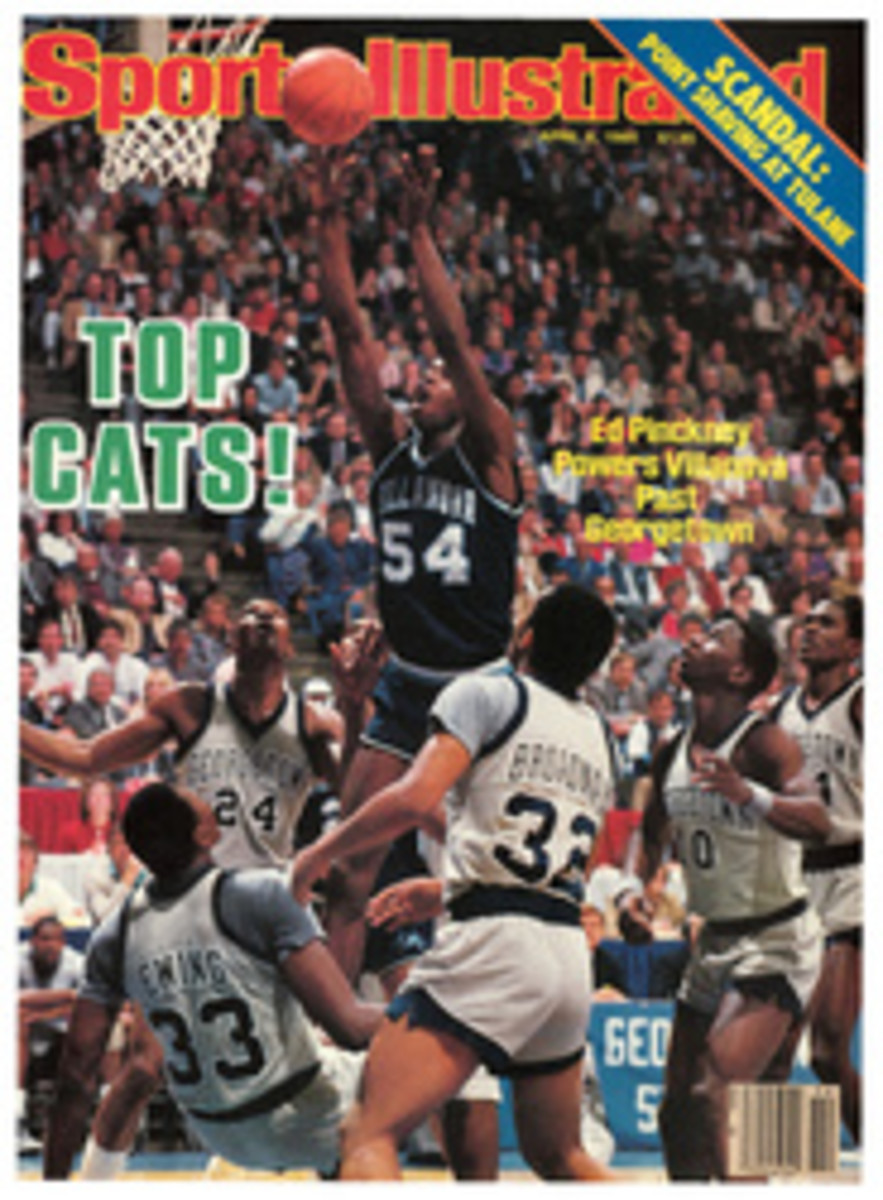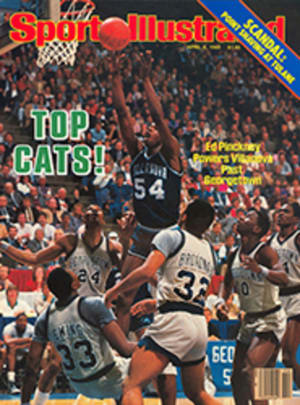
THE BROTHERS JOHNSTONE LAUNCHED A SUCCESS STORY WITH THEIR J BOATS.
A sporting revolution has been going on in the waters off Florida in recent weeks. It won't change the lives of many people, and no monuments will be raised to its heroes, but it represents a triumph of thrift over conspicuous consumption in an event given to excess, and for that it deserves at least a footnote in the history of modern sailboat racing.
Charlie Scott, a 30-year-old boatyard owner from Annapolis, Md., sailed his J/41, Smiles, to a sweep of the 1985 Southern Ocean Racing Conference, America's premier sailing event. By finishing first in class and first overall in a 75-boat fleet that included some of the world's most expensive custom-made toys, Scott and the J/41 have proved that an expertly sailed, exhaustively prepared and well-designed production-line sailboat of moderate price can win against the best that money can buy.
For all its long history and considerable prestige, the Circuit, as the SORC is known, is a little like a floating fashion show. Sailmakers, sparmakers, winch-makers, naval architects, dealers and builders use it to demonstrate their newest wares to an haute couture clientele, hoping that if the sport's elite endorse their various products, a trickle-down effect will result. Fortunes ride on the outcome of the SORC's six races, and money—the spending of it and the potential loss of it—permeates the atmosphere like swamp gas. For a production boat such as the J/41, which retails for $135,000, excluding sails and electronic gear, to beat the $200,000-to-$300,000 custom jobs that make up most of its class is not quite like the family Ford winning Le Mans, but you get the idea.
The J/41 is the family project of the Johnstones of Stonington, Conn. and Newport. It is a direct descendant of a fast 24-foot sloop called Ragtime that Rod Johnstone built in his garage in Stonington a decade ago. Ragtime proved to be such a good little boat in her first summer of racing on Block Island and Long Island sounds, winning almost every race she entered, that people wanted to buy her. When they couldn't, they wanted to duplicate her. One thing led to another, and J Boats Inc. was born, a partnership of Rod, 48, the designer, and his brother, Bob, 51, the businessman.
Until Ragtime, the Johnstone brothers were serious weekend sailors of moderate means who raced Lasers and Solings and 470s around the buoys of their home harbors. They were typical of serious small-boat racers everywhere, except that they won more often than most. They hoarded their vacation time to compete in regional and national regattas.
By the early '70s, however, each, separately—Rod in Stonington, and Bob in Wilmette, Ill.—was reaching that time in a sailor's life when he has to choose between racing small boats and seeing his family once in a while. In fact, it was Lucia, Rod's wife, who precipitated the development of the J/24 by refusing, after one particularly miserable regatta, ever to go out on the trapeze of a 470 again.
For a while thereafter Rod substituted his 14-year-old son, Jeff, as crew. "I put him on the helm and I got out on the trapeze," says Rod. "And we were awesome. The only problem was, I was going to regattas with Jeff and leaving Lucia at home with the other kids. The summer of '741 realized my small-boat sailing career was coming to an end. There was no way it was going to be a happy family experience if that kept up."
Today the Johnstones make their living from boats, and not just the borrow-from-Peter-to-pay-Paul, hand-to-mouth kind of living that the volatile business of quality boats often produces, but a rare sort of living, with fame and fortune and the respect of their peers included. J Boats has been the marine success story of the last decade. The triumph of a J/41 in the SORC is merely dessert. The J/24, built from a Ragtime mold, was the boat that put food on the table.
The J/24 is the most actively raced class boat of its size in the world, with 124 fleets in the U.S. and about 40 more around the world. When young hotshot sailors have worked their way through Sunfish, Lasers, Hobies and 470s and are ready to move on to something bigger, the J/24 is where they usually go. "Scratch an SORC skipper and you'll find a former J/24 sailor," says Rod, and then he ticks off the names: John Kolius, Dave Ullman, Buddy Melges, Eric Duchemin, Charlie Scott and so on.
J Boats Inc. was launched officially in February 1977, when Rod and Bob Johnstone became partners. It was their jointly held conviction that if what they wanted was a boat that was fast enough to win races, large enough to accommodate their families, comfortable enough to spend a night or two aboard, and cheap enough to own and still send children to college, then a lot of other people must want such a boat, too.
The Johnstones estimated that at a price of just under $10,000 each they could sell 150 J/24s in the first year, the most any manufacturer of a boat that size and in that price range had ever sold. Instead, they sold 750. Today there are more than 4,100 J/24s on the water. Because of their meticulous hand-laid construction method, a rigid sandwich of fiber glass with a balsa core, the oldest hulls are still competitive with the newest. Last year hull No. 96, built in 1977, won the J/24 North American Championship.
"Dinghy sailors were really excited about it," says Drake Johnstone, Bob's 26-year-old son, who, like most of his generation of Johnstones, was a dinghy sailor himself. "It provided a boat you could sleep on, but it also performed like a big dinghy. In a good breeze it would get up on its tail and plane at 12 or 15 knots. There wasn't anything else like it."
"It's very easy to sail," says Jeff Johnstone, now 25 and Rod's oldest son. "You don't need many crew, and you can sail it with young people who don't have much strength, because there's not much sail area."
Rod's design studio is in a small building next to the waterside home that he and Lucia share in Stonington, but the sales offices of J Boats Inc. are an hour east in Newport. There, at 24 Mill Street, in a neatly restored 189-year-old green clapboard house, Bob sells $15 million worth of J Boats a year. His daughter, Helen, 24, works for J Boats Inc. as an assistant, and his son Stuart, 27, is manager of dealer development. Jeff and Drake operate their own company, J World sailing schools, from two converted bedrooms on the second floor.
Bob and his wife, Mary, live in a condominium near the entrance to Newport Harbor. They met when she was 18 and working as a summertime nanny on Fishers Island off the Connecticut shore and he was the 19-year-old sailing teacher and harbor master at the island's Hay Harbor Club. They raised their children in South America and Illinois while Bob was working in the marketing department of Quaker Oats.
"Bob is a real ace at marketing," says Rod. "He is the reason the thing's been such a success. He knew when to push which buttons."
Bob began with the dealers. "Most people start out saying, 'We've got a good boat. Let's build it,' " he says. "We decided to stick with what we knew, designing and marketing, and got Tillotson-Pearson to build the boats. Everett Pearson is the best and most knowledgeable builder in the country, not only in terms of use of materials but in production capacity as well. If we had built a factory, we'd have been dead. Instead, we concentrated on building a network of dealers."
Faced with the untried, the dealers were dubious at first. "They said it was exactly the kind of boat they would like to have, but that it wouldn't sell," says Bob. "We had to convince them that that was the very reason it would sell. We like it. You like it. And it won't sell? That doesn't make any sense."
Next came the sailmakers, who serve as a sort of jungle telegraph within the sailing community. J Boats' first national ad was directed toward the sailmakers. The copy read, "Do yourself and your customers a favor. If you buy this boat you'll win races and all of us will come out ahead." At the first J/24 Midwinter Championship, in 1978, sailmakers were aboard or involved with almost all of the 20 boats competing. The jungle telegraph was at work.
Gradually, eight more models were added to the line, each designed to fill a specific gap in the boating market, each a success, though none on the order of the 24. A J/24 or a Hobie 16 or a Laser doesn't come along often. Rod's drawing board is currently devoted to his first pure cruising boat, the J/38. Again, market research and common sense have pointed the way. Yacht Racing & Cruising magazine did a brand-loyalty survey and found that 58% of J owners plan to buy another boat in a year and that of those, 82% plan to buy another J.
"We figure that of our 5,000 owners and the 50,000 people who sail with them, a certain percent eventually say, 'I've had enough racing. I just want to go out and cruise,' " says Bob. For that percent, the J/38 will be waiting.
The leap the Johnstones made into the IOR (International Offshore Rule) market with the J/41 and the J/34, a new IOR model that hit the water March 20 with 24 already sold, was philosophically difficult. The IOR is a mathematical formula for handicapping boats of various sizes so they can race on an equal footing. The rule makes certain assumptions about what makes a boat go fast; therefore, the job of an IOR designer is to fool the rule, to make the numbers think the boat is slower than it actually is, thereby lowering its handicap. The process is called "taking advantage of the rule," and it does not necessarily produce the fastest or the most economical boat. It produces an IOR boat intended for racing other IOR boats.
"The IOR boat is something of an anachronism, like a 1958 Cadillac with tail fins," says Rod. "They are not that fast for their size and sail area, and they are hard to sail. They require a lot of people to get the most out of them. Our J/35, which wasn't designed to the IOR, sells for less than half what the J/41 sells for and is about the same speed around the course. The only problem is, under the IOR it rates about three feet higher and is not competitive. It's crazy, but that's just the rule."
IOR racing, however, is the grand prix level of ocean racing, and a designer of high-performance sailboats like Rod Johnstone needs a track record in events such as the SORC to maintain his high-performance image. Reluctant though he may be, thanks to Charlie Scott and Smiles, Rod Johnstone is now an established IOR designer. Just as the J/24 carried his name out of the ponds and bays and into ocean racing, the J/41 has carried it into the big time.
PHOTO
DAN NERNEY
Scott was is all Smiles after he skippered the J/41 to victory in the '85 SORC.
PHOTO
[See caption above.]
PHOTO
SUSAN AIMEE WEINIK
The J24 construction features a hand-laid sandwich of fiber glass with a balsa core.
PHOTO
SUSAN AIMEE WEINIK
Rod (left) and Bob stand on watch in their office in a 189-year-old Newport building.

